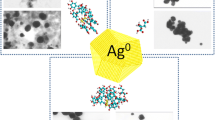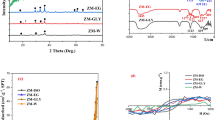Abstract
An electrochemical quartz crystal nanobalance (EQCN) has been used to study the deposition (adsorption) and dissolution (desorption) during the redox transformations of the water-soluble copper phthalocyanine-tetrasulfonic acid (CuPcTS) on a gold electrode in contact with aqueous acid solutions. The anomalous cyclic voltammetric responses that had been observed invoked the application of the EQCN technique. Indeed, it became evident that during the electroreduction in certain potential ranges, deposition/dissolution processes take place on the gold surface. Surprisingly, complex changes have been observed even when the cyclic voltammetric curves seem to be regular, i.e., characteristic to the responses of soluble redox pairs. Beside the cyclic voltammetry, EQCN was combined with galvanostatic measurements detecting the chronopotentiometric curves with the simultaneous mass changes. A reaction sequence has been suggested for the elucidation of the events occurring during the reduction and reoxidation of CuPcTS.








Similar content being viewed by others
References
Acres GJK, Eley DD (1964) Activation of hydrogen by poly copper phthalocyanine. Trans Faraday Soc 60:1157–1169
Akinbulu IA, Ozoemena KI, Nyokong T (2011) Formation, surface characterization, and electrocatalytic application of self-assembled monolayer films of tetra-substituted manganese, iron, and cobalt benzylthio phthalocyanine complexes. J Solid State Electrochem 15:2239–2251
Alpatova NM, Ovsyannikova EV (2011) Electropolymerization of phthalocyanines. In: Cosnier S, Karyakin A (eds) Electropolymerization. Wiley, Weinheim, pp 111–132
Arici M, Arican D, Lütfi Ugur A, Erdogmus A, Koca A (2013) Electrochemical and spectroelectrochemical characterization of newly synthesized manganese, cobalt, iron and copper phthalocyanines. Electrochim Acta 87:554–566
Bertoncello P, Peruffo M (2008) An investigation on the self-aggregation properties of sulfonated copper(II) phthalocyanine (CuTsPc) thin films. Colloids & Surfaces A: Physicochem Eng Aspects 321:106–112
Borsos K, Inzelt G (2015) Electrochemical and nanogravimetric studies of poly(copper phthalocyanine) microparticles immobilized on gold in aqueous solutions. J Solid State Electrochem 19:2565–2577
Borsos K, Inzelt G (2016) A new electrode for acid-base titration based on poly(copper phthalocyanine). J Solid State Electrochem 20:1215–1222
Brown RJC, Brett DJL, Kucernak ARJ (2009) An electrochemical quartz crystal microbalance study of platinum phthalocyanine thin films. J Electroanal Chem 633:339–346
Caro CA, Zagal JH, Bedioui F (2003) Electrocatalytic activity of substituted metallophthalocyanines adsorbed on vitreous carbon electrode for nitric oxide oxidation. J Electrochem Soc 150:E95–E103
Gaffo L, Goncalves D, Faria RC, Moreira WC, Oliveira ON Jr (2005) Spectroscopic, electrochemical, and microgravimetric studies on palladium phthalocyanine film. J Porphyrins Phthalocyanines 9:16–21
Inzelt G (2010) Electrochemical quartz crystal nanobalance. In: Scholz F (ed) Electroanalytical methods, 2nd edn. Ch. II. 10. Springer, Berlin, Heidelberg, pp 257–270
Jansen R, Beck F (1994) Electrochemical characterization and transformation of redox states at the surface of metallophthalocyanines. Electrochim Acta 39:921–931
Jiang J, Kucernak AR (2001) The electrochemistry of platinum phthalocyanine microcrystals. IV. Temperature dependence of the electrochemical behaviour in non-aqueous solution. Electrochim Acta 46:3445–3456
Kimura M, Muto T, Takimoto H, Wada K, Ohta K, Hanabusa K, Shirai H, Kobayashi N (2000) Fibrous assemblies of amphiphilic metallophthalocyanines. Langmuir 16:2078–2082
Komorsky-Lovrić S (1995) Voltammetry of microcrystals of cobalt and manganese phthalocyanines. J Electroanal Chem 397(1–2):211–215
Kreja L, Czerwinski W (1992) A study of iodine influence on the electrical properties of phthalocyanines and polyphthalocyanines of some metals. J Materials Sci Lett 11:538–540
Leznoff CC, Lever APB (1989-1996) Phthalocyanines: properties and applications, vol 1-4. VCH Publ, New York
Meier H, Albrect W, Zimmerhackl E (1985) Photoconductivity of copper phthalocyanine. Polym Bull 13:43–50
Moraes FC, Mascaro LH, Machado SAS, Brett CMA (2010) Direct electrochemical determination of glyphosate at copper phthalocyanine/multiwalled carbon nanotube film electrodes. Electroanalysis 22:1586–1591
Nemes Á, Inzelt G (2014) Electrochemical and nanogravimetric studies of iron phthalocyanine microparticles immobilized on gold in acidic and neutral media. J Solid State Electrochem 18:3327–3337
Nemes Á, Moore CE, Inzelt G (2013) Electrochemical and nanogravimetric studies of palladium phthalocyanine microcrystals. J Serb Chem Soc 78:2017–2037
Nishida KRA, Wiggins BC, Hipps KW, Mazur U (2011) Aggregation of sulfonated free-base phthalocyanine on gold as a function of solution pH. J Porphyrins and Phthalocyanines 15:459–466
Ogunsipe AO, Idowu MA, Ogunbayo TB, Akinbulu IA (2012) Protonation of some non-transition metal phthalocyanines-spectral and photophysicochemical consequences. J Porphyrins Phthalocyanines 16:885–894
Raïssi M, Vignau L, Ratier B (2014) Enhancing the short-circuit current, efficiency of inverted organic solar cells using tetra sulfonic copper phthalocyanine (TS-CuPc) as electron transporting layer. Organic Electronics: physics, material, application 15:913–919
Reis RM, Valim RB, Rocha RS, Lima AS, Castro PS, Bertotti M, Lanza MRV (2014) The use of copper and cobalt phthalocyanines as electrocatalysts for the oxygen reduction reaction in acid medium. Electrochim Acta 139:1–6
Reynolds JR, Pyo M, Qiu YJ (1994) Charge and ion transport in poly(pyrrole copper phthalocyanine tetrasulfonate) during redox switching. J Electrochem Soc 141:35–40
Sakamoto K, Ohno-Okumura E (2009) Syntheses and functional properties of phthalocyanines. Materials 2:1127–1179
Selvaraj C, Munichandraiah N, Scanlon LG (2012) Dilithium phthalocyanine as a catalyst for oxygen reduction in non-aqueous Li-O2 cells. J Porphyrins Phthalocyanines 16:255–259
Sokolova TN, Lomova TN, Klueva ME, Suslova EE, Mayzlish VE, Shaposhnikov GP (2000) Structure-stability relationships of phthalocyanine copper complexes. Molecules 5:775–785
Sousa AL, Santos WJR, Luz RCS (2008) Amperometric sensor for nitrite based on copper tetrasulphonated phthalocyanine immobilized with poly-L-lysine film. Talanta 75:333–338
Srivasta KP, Kumar A (2001) UV spectral studies in protonation of Cu-phthalocyanine and phthalocyanine in sulphuric acid-solvent. Asian J Chem 13:1539–1543
Su JL, Xue MZ, Ma N, Sheng QR, Zhang Q, Liu YG (2009) Dissolution of copper phthalocyanine and fabrication its nano-structure film. Sci China Ser B-Chem 52:911–915
Yamazaki S, Fujiwara N, Yasuda K (2010) A catalyst that uses a rhodium phthalocyanine for oxalic acid oxidation and its application to an oxalic acid sensor. Electrochim Acta 55:753–758
Acknowledgements
Financial support of the National Scientific Research Fund (OTKA K100149) is gratefully acknowledged.
Author information
Authors and Affiliations
Corresponding author
Rights and permissions
About this article
Cite this article
Inzelt, G., Nemes, Á. & Sajti, Á. Study of the surface mass changes during the redox transformations of copper(II) phthalocyanine-tetrasulfonic acid on gold in acidic media. J Solid State Electrochem 21, 1725–1732 (2017). https://doi.org/10.1007/s10008-017-3547-x
Received:
Revised:
Accepted:
Published:
Issue Date:
DOI: https://doi.org/10.1007/s10008-017-3547-x




